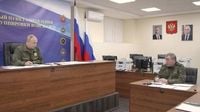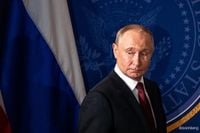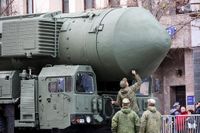Russian President Vladimir Putin has once again thrust his country’s military might into the global spotlight, claiming a successful test of the Burevestnik nuclear-powered cruise missile—a weapon he calls “invincible” and capable of circumventing all current and future missile defense systems. The announcement, made on October 26, 2025, has sent ripples through international security circles and reignited fears of a new era in the nuclear arms race, as reported by multiple sources including Reuters, BBC, and the Daily Mail.
Appearing in military fatigues in a Kremlin-released video, Putin hailed the Burevestnik as a “unique” addition to Russia’s arsenal. He ordered his top general, Valery Gerasimov, to begin preparing the infrastructure necessary for its deployment. “We need to determine the possible uses and begin preparing the infrastructure for deploying these weapons to our armed forces,” Putin instructed, according to Reuters.
The Burevestnik, known to NATO as “Skyfall” and ominously nicknamed the “Flying Chernobyl” due to its nuclear propulsion and potential radioactive exhaust, is shrouded in secrecy. Russian officials claim the missile boasts a nearly unlimited range and an unpredictable flight path, making interception virtually impossible. Gerasimov, Chief of the General Staff, detailed the results of the latest test: “The missile flew for 15 hours non-stop, covering a distance of 14,000 kilometers [8,700 miles],” he said, as quoted by Daily Mail. “And that’s not the limit. It is nuclear-powered. The technical characteristics of the Burevestnik generally allow it to be used with guaranteed accuracy against highly protected targets at any distance.”
Putin first announced the Burevestnik project seven years ago, touting it as a technological leap that would render Western missile defenses obsolete. He reiterated these assertions during his recent briefing, boasting, “The modernity of our… nuclear deterrent forces, is at the highest level. Well, it would probably be no exaggeration to say that it is at a higher level than all nuclear states.”
However, Western intelligence agencies and nonproliferation experts remain skeptical. According to the Nuclear Threat Initiative, the Burevestnik’s testing history has been far from stellar, with only two partial successes out of 13 known tests. Despite the Kremlin’s bravado, doubts persist about whether the missile truly possesses the capabilities that Russian officials claim. BBC notes that Moscow’s statements about the missile have often been “greatly exaggerated.”
The timing of the missile test is as significant as the technology itself. The test occurred on October 21, 2025, just days after a proposed peace summit in Budapest—floated by U.S. President Donald Trump to discuss the Ukraine conflict—collapsed. Instead, the U.S. government imposed new sanctions on Russia’s two largest oil producers, Rosneft and Lukoil, and reignited discussions in Washington about possibly supplying Tomahawk cruise missiles to Ukraine. Putin has previously called the potential deployment of Tomahawks in Ukraine an escalation, and his latest display of nuclear capability seems aimed at sending a pointed message to both Washington and Kyiv.
Simultaneously, the war in Ukraine grinds on with deadly consequences for civilians. As Putin and Gerasimov discussed the Burevestnik’s success, Russian missiles and drones were raining down on Kyiv. According to Ukrainian President Volodymyr Zelensky, at least three people were killed and 29 wounded—including seven children—during overnight attacks on residential buildings in the capital. “Every Russian strike is an attempt to inflict as much damage as possible on ordinary life,” Zelensky said on X (formerly Twitter), as cited by BBC. “These are strikes on residential buildings, on our people, on children, on civilian infrastructure. These are the main targets for the Russians.”
Kyiv Mayor Vitali Klitschko confirmed the casualties and the destruction, stating that Russia launched 101 drones at Ukraine, with 90 being shot down by air defense forces. The Russian Defense Ministry, for its part, claimed to have intercepted 82 Ukrainian drones overnight. The battle for air supremacy over Ukraine remains fierce, with technology and tactics evolving on both sides.
On the diplomatic front, Kirill Dmitriev, Putin’s special envoy for investment and economic cooperation, was in the United States during the missile announcement. Dmitriev posted images on his Telegram channel of souvenir chocolates decorated with Putin’s image, noting they were prepared “within the framework of the Russia–US dialogue.” While the gesture may seem trivial, it underscores the complex and often contradictory nature of current Russia-U.S. relations—where symbolic gifts are exchanged even as new weapons are unveiled and sanctions imposed.
Meanwhile, on the ground in Ukraine, the situation remains dire. Gerasimov claimed that Russian forces had encircled the city of Kupyansk in the Kharkiv region, though this assertion could not be independently verified. Ukrainian officials maintain that their troops are holding the line and repelling Russian attacks in the area. The cycle of claim and counterclaim continues, with civilians bearing the brunt of the violence.
The Burevestnik’s test and Putin’s subsequent rhetoric have drawn sharp criticism from Western governments and nonproliferation advocates, who warn that the development of such weapons could lower the threshold for nuclear use and increase the risk of catastrophic accidents. The missile’s nuclear propulsion system, which emits radioactive exhaust, has sparked particular concern among environmentalists and arms control experts. The nickname “Flying Chernobyl” alludes to the 1986 nuclear disaster, raising fears of potential ecological fallout should the missile malfunction or crash.
Despite these warnings, Putin appears undeterred. He admitted that the Burevestnik is not yet ready for combat deployment, but made it clear that Russia’s efforts to modernize its arsenal will continue. “A large amount of work needed to be conducted before that could be done,” he acknowledged, according to Reuters. But the message was unmistakable: Russia intends to maintain, and if possible, expand its strategic edge.
As the world grapples with the implications of Russia’s latest military demonstration, the risk of miscalculation looms large. With peace talks stalled, sanctions tightening, and advanced weaponry entering the fray, the potential for escalation remains ever-present. The Burevestnik missile—whether it truly lives up to the hype or not—has already succeeded in one respect: forcing the world to pay attention, and raising the stakes in an already volatile conflict.
For now, the Burevestnik stands as both a symbol of Russian ambition and a stark reminder of the dangers inherent in the nuclear age. As leaders on all sides weigh their next moves, the world watches anxiously, hoping that deterrence and diplomacy will prevail over brinkmanship and war.






